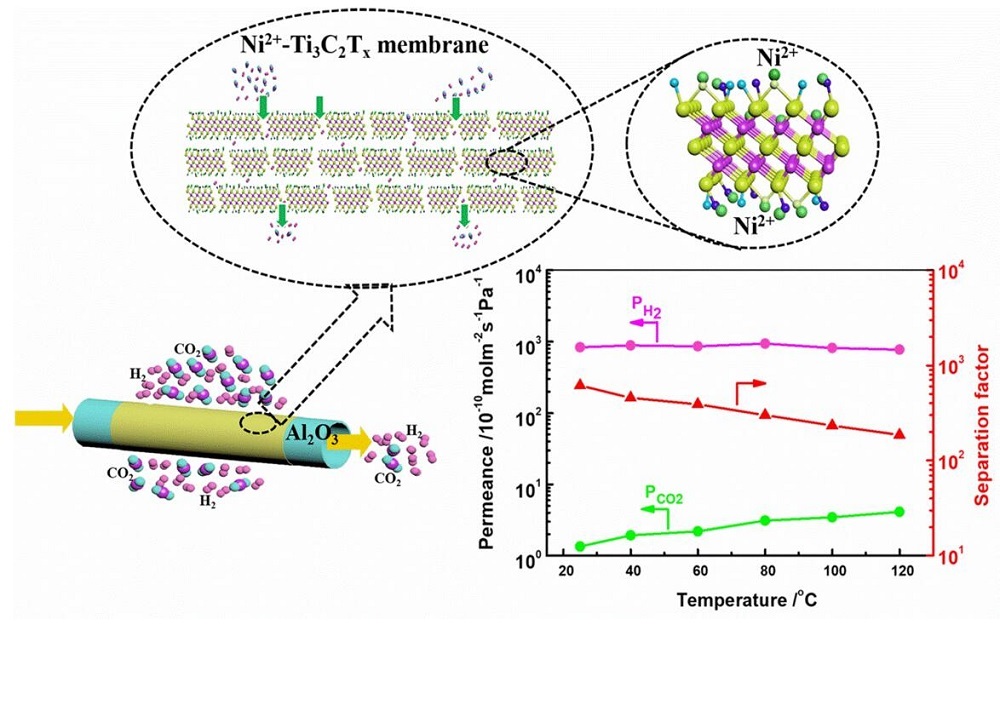Single-gas permeation was carried out using a series of single gases with different kinetic diameters at room temperature to explore the molecular sieving properties of the Ni
2+-Ti
3C
2T
x/Al
2O
3 membrane further. As shown in Fig. 7(a), the permeability of small gas molecules (He or H
2) was much higher than those of gas molecules with large kinetic diameters such as CO
2, N
2, and CH
4. Permeances declined in the order of H
2 (0.289 nm), He (0.26 nm), CH
4 (0.384 nm), N
2 (0.364 nm), CO
2 (0.33 nm), which is consistent with other researchers [
9,
48]. The higher permeance for the sphere CH
4 molecules than the rod-shape N
2 molecules was attributed to the molecular shape; the sphere molecules might be easier to permeate through nanochannels of Ni
2+-Ti
3C
2T
x membranes due to less steric hindrance [
9,
42,
49]. The less permeable CO
2 was due to not only the rod-like shape of the molecule but also the extremely strong quadrupole moment than N
2 and CH
4. The ideal selectivity of H
2/CO
2 was about 750, far exceeding the Knudsen selectivity of 4.7. The ideal selectivities of other gas pairs, i.e., H
2/N
2, H
2/CH
4, were 430 and 240, respectively. This superior selectivity was much higher than that of other 2D separation membranes [
50–
52]. This finding presents potential applications of the composite membranes to separation of H
2 from a mixture gas containing hydrogen. Figure 7(b) displays that the permeance of H
2 and CO
2 for Ni
2+-Ti
3C
2T
x/Al
2O
3 membrane increased with increasing the temperature from 25 °C to 120 °C. The separation factor of H
2/CO
2 decreased from 650 at 25 °C to 186 at 120 °C because the permeance of CO
2 increased more rapidly than H
2 with increasing temperature. A long-term permeation measurement was carried out for H
2/CO
2 mixture at the operation temperature of 25 °C to verify the stable separation performance of the composite membrane. As shown in Fig. 7(c), the composite membrane maintained an excellent separation performance and no substantial change of the permeance during more than 200-hour long-term operation testing. This result indicates that the Ni
2+-Ti
3C
2T
x/Al
2O
3 membrane was mechanically robust such that no defects were generated under the longtime continuous gas permeation, which is important for dealing with mixtures containing hydrogen in practical industries [
22]. Compared with previously reported membranes, the supported Ni
2+-Ti
3C
2T
x membrane exhibited a superior H
2 selectivity, which considerably exceeds the latest upper bound of most current membranes, as shown in Fig. 7(d) [
9,
10,
12,
17,
22,
31,
33,
48,
51–
59]. The unprecedented preferential H
2 permeation could be due to the increasing interlayer spacing and capture of CO
2 from the unique cation intercalation between the adjacent Ti
3C
2T
x laminates similar with the metal ion-modified MOFs [
60].










